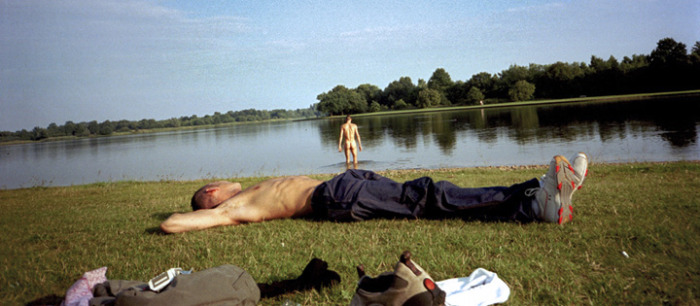Environmental Pictures
 Raoul & Theo on the Lake in Enschede, Netherlands, 2001
Raoul & Theo on the Lake in Enschede, Netherlands, 2001
It is necessary to travel. It is not necessary to live.
William S. Burroughs
I took my best pictures while traveling. That is when I felt most inspired, free and alive, sometimes living out of my suitcase for months at a time, like a nomad with no specific goal in mind other than a constant change of settings and escape from the boring daily routine, schedule, regiment… And what a reward it is to come back home with a bagful of shot film! The moment of sharing your impressions and memories can be just as exciting as the journey itself.
I might have some gypsy blood in my genes: my Dad couldn’t settle in one place for more than a couple of years, and throughout my childhood, my family was constantly moving around Russia from one corner of the country to another. Taking advantage of his job as a newspaper journalist, my father crisscrossed the mammoth Soviet empire and even traveled as far as Mongolia and Bulgaria.
Back in Communist times, the prospect of leaving the country seemed almost unreal. The closest I got to Europe was visiting Estonia and Latvia, the former Soviet Baltic republics. All that changed with the fall of the Iron Curtain. At seventeen, I went to Paris for the first time, a year later visited California, and at twenty-one, I had to leave Russia altogether escaping homophobic political prosecution. As soon as I received my refugee status and the UN travel pass, I started traveling the world—with my camera as my best companion. My appetite for exploring new places and cultures was enormous—the more exotic, the better. That’s when I started taking Environmental Pictures—a visual diary of my travels—and the panoramic format has proven to be ideal for documenting vast landscapes, open skies, empty environments and naked horizons.
Morocco, like Russia, is a true photographer’s paradise. The photos I took there became one of the central parts of this series. Once, on a busy market street in the medina of Tangier, my camera was snatched from my pocket by one of many skillful Moroccan pickpockets. When I realized what had just happened, I was devastated. And then a true miracle occurred: watching me walking back and forth on that same street, trying to spot the thieves, a couple of guys came up to me and handed me my camera. It was my favorite old Rollei, which probably seemed too used-up for them to sell or make any money on. I think I was the only Westerner robbed in Morocco who was given back his stolen possession. The miracle happened in a city with a long decadent tradition of Jean Cocteau, Jean Genet, Paul Bowles, Brion Gysin and Burroughs, to name just a few. I took it as a sign, as a kind of blessing or auspice.
While in Morocco, I went on a pilgrimage to Genet’s grave in Larache, an ancient harbor town a couple of hours away from Tangier. Twenty years after his death, the town hasn’t changed a bit, with the exception of a handful of Internet cafes and satellite TV dishes on the roofs of every other house. At the Catholic cemetery, the guide boy, who didn’t speak a word of English, opened the gate and when I mentioned Genet’s name, showed me the way to his modest tombstone, bleached out by the harsh Northern African sun. As I was taking his picture, the boy had a happy big smile on his face—the kind of smile that only people in very poor countries still have. He earned his coins. I made his day. Clearly, he didn’t have a clue about the nature of Genet’s fame and why anyone would want to visit his lonely grave.
Slava Mogutin, New York City, June 2009